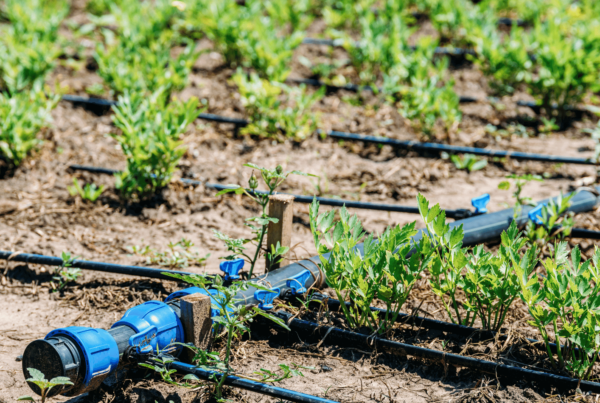Unlocking the Power of IoT in Agriculture: Sensoterra’s Journey
At Sensoterra, our mission is clear: we design and produce state-of-the-art wireless soil moisture sensors that provide farmers and landscapers with the ability to monitor soil conditions at multiple locations simultaneously. With the power of IoT soil moisture sensors, we’re enabling growers to optimize their irrigation decisions, conserve water, and enhance crop yields. In this blog, Daan Roethof, Product Developer at Sensoterra, shares insights into the challenges faced during sensor development and how we’re leveraging technology to transform the agricultural landscape.
Meeting Challenges Head-On
Sensoterra’s journey has been marked by a series of challenges, each contributing to the refinement of our soil moisture sensors. Our primary objective is to create user-friendly, rugged, fail-proof, and watertight sensors that can withstand the elements. These sensors are deployed in diverse environments, from the back of a truck to wet fields, exposed to rain, wind, and sun. Overcoming these challenges involved simplifying the sensors to their bare minimum. By eliminating buttons, switches, and LEDs, we created a closed box, which, although challenging, paved the way for innovative solutions.
Turning Sensors On and Off
One key challenge in developing our sensors was determining how to switch them on and off efficiently. Modern electronics have the capability to enter deep sleep mode, conserving energy. Our sensors follow an hourly pattern: they measure soil moisture, encode data, transmit it, and then sleep for an hour, repeating the cycle. The energy consumption during measurement is minimal compared to LoRaWAN radio communication. Therefore, sensors not in use can enter an energy-efficient “stock mode.” However, the challenge was how to activate the sensors in the soil. We addressed this by adding a capacitive sensor that detects when growers shake the sensor. This prompts the sensor to wake up immediately, ensuring real-time data availability on the user’s smartphone.

Switching Modes and Leveraging LoRaWAN
Upon their initial activation, our sensors enter “factory mode,” which helps us conduct quality control checks during manufacturing. To transition sensors to the standard mode, allowing them to be customer-ready, a downlink is required. This process is made possible through The Things Network (TTN), a LoRaWAN network. TTN offers several key advantages in addressing these challenges. It allows an unlimited number of sensors for free per user, enabling us to register all sensors from production. This empowers us to manage sensor energy consumption, control stock levels, and configure downlink settings before sensors are sent to customers.
Testing and Development
Sensoterra sensors undergo extensive testing in our office and laboratory. TTN’s open framework doesn’t limit us in terms of uplink usage, which is critical for testing and collecting valuable data efficiently. This allows us to push the boundaries and regularly explore the limits of LoRaWAN specifications. Additionally, TTN offers gateway setups that are both user-friendly and cost-effective, making it an ideal choice for setting up public networks.
The Things Network: Empowering IoT Innovation
The Things Network is revolutionizing IoT by enabling low-power devices to connect to long-range gateways in a decentralized, open-source network. This connectivity is empowering various applications, including agriculture, smart cities, landscaping, horticulture, and smart devices. TTN’s capabilities are fundamental to the success of Sensoterra and the transformative solutions we provide to the agricultural industry.
The Sensoterra Difference
With thousands of Sensoterra sensors deployed globally, generating over 60 million data points, Sensoterra is a pioneer in smart agriculture sensor technology. Our sensors are designed to thrive in both urban and rural environments, providing critical data for farmers and landscapers.
About Sensoterra
Sensoterra is a pioneering leader in the field of wireless soil moisture sensors, offering cutting-edge IoT soil moisture sensor solutions for smart agriculture. Our state-of-the-art Sensoterra soil moisture sensors are at the forefront of agriculture IoT, providing unparalleled soil moisture monitoring capabilities.
Our commitment to precision agriculture technology allows farmers to make informed decisions, optimize their irrigation systems, and embrace sustainable farming solutions. With Sensoterra, access to real-time soil moisture data is at your fingertips, enabling precise water management and water resource management for your agricultural operations.
Sensoterra, established in 2015, with its headquarters in Houten, The Netherlands, develops water management solutions for agriculture/horticulture, smart city management, and water governance. Sensoterra has over 12,000 sensors in the ground globally, and generates hundreds of thousands of data points for smart water management, daily. Learn more at www.sensoterra.com
Contact for more information, pictures and/or interview requests:
Jessica Nuboer
Marketing & Communications
Sensoterra
Email: [email protected]






